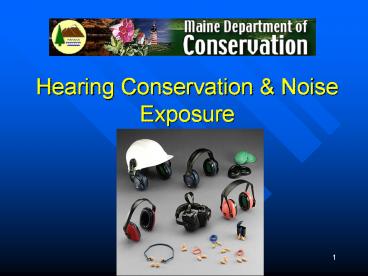Hearing Conservation - PowerPoint PPT Presentation
Title:
Hearing Conservation
Description:
Hearing Conservation & Noise Exposure – PowerPoint PPT presentation
Number of Views:302
Avg rating:3.0/5.0
Title: Hearing Conservation
1
Hearing Conservation Noise Exposure
2
Objectives
- What is sound?
- How the ear works
- How to measure noise
- What does OSHA says about noise?
- Reading hearing tests
- Hearing Protection
3
What is Sound?
- Hertz (Hz)
- Frequency a high or low pitch
- Decibels (dB)
- The loudness of the sound
4
Frequency
- Humans can typically hear between 20 - 20,000 Hz
- You can hear different frequencies better than
others
5
Decibels
- The quietest sound most humans can detect is 0 dB
- Some humans can even hear sounds as quiet as -5 dB
6
The Loudness of Common Sounds
Noise Thermometer Click Here
7
Anatomy of the Ear
Ear Drum
Semi-Circular Canals
Cochlea
Ear Bones
8
How do we Hear?
- The outer ear collects the sound waves
- The waves hit the eardrum, and cause it to
vibrate - The vibrations are sent through the ear bones to
the cochlea
9
Inside the Cochlea (snail shell)
- Delicate hair cells vibrate to different
frequencies - Hair cells detect the vibration, and send a
signal to the brain - Loud sounds destroy the hair cells, and they stop
functioning FOREVER!
10
The Ear does something else too!
- The Semi-circular canals
- Three tubes laying perpendicular to one another
- Filled with fluid and tiny hair cells
- When your head is tilted, the fluid moves the
hair cells, and they send a signal to your brain - Responsible for balance
11
How to measure noise
- Decibels are measured on a logarithmic scale
- Every time you add 5 dB, you double the sound.
- 80 dB 85 dB
An addition or reduction of 5dB causes either an
addition or reduction of 100 in noise according
to OSHA.
12
Example
- In the field, we determined the loudness of two
compressors right next to each other - How loud is this area?
- Do we add?
- Do we add and take the average?
89 dB
87 dB
?
13
- Neither, because it is a log scale
- We use the following chart
- 82 dB 83 dB 86 dB
- 87 dB 89 dB 91 dB
14
How does the Safety Person determine noise levels
- Sound level meter
- Determine the loudness (dB) of noise at any given
moment
- Personal Dosimeters
- Worn by employees
- Measures the average loudness in an 8 hour work
shift - 8hr. TWA (Time Weighted Average)
- Can also measure noise dose
15
What does BLS say?
- At 85 dB (8hr. TWA) (50 Dose)
- Train employees
- Make hearing protection available
- Sample for noise levels
- Do hearing tests
- Notify employees of results
- At 90 dB or more
- (100 Dose)
- We must keep levels at or below 90 dB
- Or require hearing protection that will lower
noise levels to to 90 dB
16
Hearing Tests
- Determine a baseline audiogram
- Hearing test every year to determine if you have
experienced a hearing loss (Standard Threshold
Shift) - Standard Threshold Shift - A loss of 10 dB or
more at 2000, 3000, or 4000 Hz.
17
Hearing Loss
- Impact - One loud bang
- Cumulative - Years of a noisy environment
- Tinnitus - Ringing in the ears
- Presbycusis - Hearing loss due to aging
18
Hearing Protection
- NRR - Noise reduction rating
- Ear Plug - 25 NRR
- Ear Plug - 29 NRR
- Ear Plug - 30 NRR
- DO NOT Subtract the NRR from the noise level
- WRONG (109 dB - 25 NRR 84 dB)
- You must use the Safety Factor. explained on
separate slide
19
Safety Factor
- OSHA says the hearing protection is designed to
reduce the noise by the NRR, but that is unlikely
to happen due to - Leaks in the seal
- Vibration
- Improper insertion
20
Example of NRR Protection
- The noise from an average chainsaw is 110 dB
- You are wearing the foam plugs with an NRR of 25
- Do you have enough protection to place you below
90 dB level?
21
- (NRR 25 - 7) 18
- 18 / 2 9
- - 9
- YOU ARE ABOVE OSHA LIMITS OF 90 dB
110 dB
101
22
Final Thoughts
- Hearing is important
- In time, noise levels at 85 dB can permanently
damage your hearing - Wear your hearing protection both at work and at
home - Choose hearing protection with a proper NRR, and
wear it properly
23
Resources
- SafetyWorks! 1-877-723-3345
- OSHA-
- NIOSH
- CDC -

